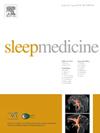Can Sniff Nasal Inspiratory Pressure be a guide in detecting of sleep-disordered breathing in children with Duchenne Muscular Dystrophy?
IF 3.8
2区 医学
Q1 CLINICAL NEUROLOGY
引用次数: 0
Abstract
Purpose
Duchenne muscular dystrophy (DMD) is a severe, progressive condition characterized by muscle degeneration and weakness, significantly affecting respiratory function. This study aimed to evaluate the presence of sleep-disordered breathing (SDB) in children with DMD and investigate the relationships between sleep and respiratory function using spirometry, sniff nasal inspiratory pressure (SNIP), and polysomnography (PSG) along with capnography.
Research question
Can low SNIP be a guide for detecting respiratory muscle involvement early and determining the right time to perform early PSG and capnography in DMD?
Study design
Prospective, observational, cross-sectional study.
Methods
This study included DMD patients aged <18 years. Pulmonary function tests were conducted using spirometry and SNIP, and maximum inspiratory and expiratory pressure were measured. PSG and capnography were performed within two weeks after the pulmonary function tests, and their relationships with each other were investigated.
Results
The study included 44 children. Obstructive sleep apnea syndrome (OSAS) was present in 70.5 % of patients, while nocturnal hypoventilation was observed in 4.5 %. SNIP values were significantly lower in patients with moderate-to-severe OSAS than in those without OSAS. An SNIP value below 40 cm H2O was associated with a 92.8 % prevalence of OSAS.
Conclusion
SNIP is a valuable, noninvasive marker for the early detection of respiratory muscle involvement and SDB in patients with DMD. This study highlights the need for early and regular respiratory monitoring in children with DMD to enhance care and quality of life.
嗅鼻吸气压力能否指导检测杜兴氏肌肉萎缩症儿童的睡眠呼吸障碍?
目的:杜氏肌营养不良症(DMD)是一种严重的进行性疾病,以肌肉变性和无力为特征,严重影响呼吸功能。本研究旨在评估 DMD 患儿是否存在睡眠呼吸障碍(SDB),并使用肺活量测定法、嗅鼻吸气压力(SNIP)和多导睡眠图(PSG)以及毛细血管造影术研究睡眠与呼吸功能之间的关系:研究问题:低鼻吸气压能否作为早期检测呼吸肌受累的指南,并确定在 DMD 患者中进行早期 PSG 和脑电图检查的正确时间?研究设计:前瞻性、观察性、横断面研究:本研究纳入了年龄为 15 岁的 DMD 患者:研究包括 44 名儿童。70.5%的患者存在阻塞性睡眠呼吸暂停综合征(OSAS),4.5%的患者夜间通气不足。中重度阻塞性睡眠呼吸暂停综合症患者的 SNIP 值明显低于无阻塞性睡眠呼吸暂停综合症的患者。SNIP值低于40 cm H2O与92.8%的OSAS患病率相关:结论:SNIP 是早期发现 DMD 患者呼吸肌受累和 SDB 的重要无创标志物。这项研究强调了对 DMD 儿童进行早期和定期呼吸监测以提高护理和生活质量的必要性。
本文章由计算机程序翻译,如有差异,请以英文原文为准。
求助全文
约1分钟内获得全文
求助全文
来源期刊

Sleep medicine
医学-临床神经学
CiteScore
8.40
自引率
6.20%
发文量
1060
审稿时长
49 days
期刊介绍:
Sleep Medicine aims to be a journal no one involved in clinical sleep medicine can do without.
A journal primarily focussing on the human aspects of sleep, integrating the various disciplines that are involved in sleep medicine: neurology, clinical neurophysiology, internal medicine (particularly pulmonology and cardiology), psychology, psychiatry, sleep technology, pediatrics, neurosurgery, otorhinolaryngology, and dentistry.
The journal publishes the following types of articles: Reviews (also intended as a way to bridge the gap between basic sleep research and clinical relevance); Original Research Articles; Full-length articles; Brief communications; Controversies; Case reports; Letters to the Editor; Journal search and commentaries; Book reviews; Meeting announcements; Listing of relevant organisations plus web sites.
 求助内容:
求助内容: 应助结果提醒方式:
应助结果提醒方式:


